
EPJ Nuclear Sci. Technol. 5, 17 (2019)
c
P. German et al., published by EDP Sciences, 2019
https://doi.org/10.1051/epjn/2019034
Nuclear
Sciences
& Technologies
Available online at:
https://www.epj-n.org
REGULAR ARTICLE
Application of multiphysics model order reduction
to doppler/neutronic feedback
Peter German1, Jean C. Ragusa1,*,and Carlo Fiorina2
1Texas A&M University, Department of Nuclear Engineering, College Station, TX 77840, USA
2Ecole Polytechnique F´
ed´
erale de Lausanne, Laboratory of Reactor Physics and Systems Behaviour, PH D3 465
(Batiment PH), Station 3, 1015 Lausanne, Switzerland
Received: 19 May 2019 / Received in final form: 26 September 2019 / Accepted: 27 September 2019
Abstract. In this paper, a proper orthogonal decomposition based reduced-order model is presented for
parametrized multiphysics computations. Our application physics is Doppler feedback in a simplified model of
the molten salt fast reactor concept. The reduced model is created using the method of snapshots where the
offline training set is obtained by exercising a full-order model created with the OpenFOAM based multiphysics
solver, GeN-Foam. The steady state models solve the multi-group diffusion k-eigenvalue equations with moving
precursors together with the energy equation. A fixed velocity field is assumed throughout the computations,
hence the momentum and continuity equations are not solved. The discrete empirical interpolation method
is used for the efficient coupling of the ROM solvers, while the input parameter space is surveyed using the
improved distributed latin hypercube sampling algorithm.
1 Introduction
Molten salt reactor (MSR) designs were originally devel-
oped in the mid-1950s at Oak Ridge National Laboratory
(ORNL, USA) [1–3]. In MSRs, the nuclear fuel is in liq-
uid form, dissolved in a salt. Salt compositions vary, but
are typically based on fluorides or chlorides and include
one or more of the following compounds: LiF, NaF, BeF2,
ZrF4, KF, NaCl, MgCl2. Diverse variations on that reac-
tor concept were investigated in the 1960s and 1970s,
including graphite-moderated thermal-spectrum reactors
at ORNL [4,5] as well as fast-spectrum burner reac-
tors at Argonne National Laboratory [6,7]. In the early
1970s, MSR research was in competition for U.S. fed-
eral funding with sodium-cooled fast reactor systems and
the MSR research in the USA dwindled down to low-
priority, low-funding efforts over the following decades,
while the thermal-spectrum light water-cooled pressur-
ized and boiling water reactors and the sodium-cooled fast
reactors became the reference baseline worldwide for ther-
mal and fast spectrum systems, respectively. Nonetheless,
electricity-production priorities and safety requirements in
the nuclear sector have evolved over the last 50 years and
MSRs are now one of the six concepts selected for further
investigation in the frame of the Generation-4 Interna-
tional Forum [8]. MSRs have highly promising features in
terms of sustainability and safety features. Indeed liquid-
fueled MSRs can be designed to have strong negative-only
*e-mail: jean.ragusa@tamu.edu
reactivity feedbacks; they operate at atmospheric pres-
sure; they allow for an online removal of gaseous fission
products; and they give the possibility to drain the fuel
salt in passively cooled and critically-safe tanks in case
of emergency. Most fast-spectrum MSRs currently under
development are based on pumped-loop designs, where
the fuel salt is pumped outside of the primary vessel
and transfers heat to a secondary coolant in separate
heat exchangers. Examples of fast-spectrum molten salt
reactor designs include: the MOlten Salt Actinide Recy-
cler and Transforming (MOSART) project [9], the Molten
Salt Fast Reactor (MSFR) concept based on fluoride
salt, developed in the EVOL (Evaluation and Viability
of Liquid Fuel Fast Reactors) [10–12] and then SAMO-
FAR (Safety Assessment of the Molten Salt Fast Reactor)
[13] programs under the auspices of EURATOM, and the
Molten Chloride Fast Reactor (MCFR), currently devel-
oped by Terrapower [14]. Loop-type fast-spectrum molten
salt reactors present new modeling challenges:
– the fuel is in liquid form, yielding a more complex
level of multiphysics coupling than traditional light
water reactors (e.g., velocity fields needed to assess
space/time location of fuel and delayed neutron
precursors);
– turbulent fuel-salt flow, leading to a large impact
of turbulence modeling (thermal flow mixing in the
core, effects of nozzle inlets,... [15]);
– presence of gas bubbles in the salt, leading to
compressibility and reactivity effects;
This is an Open Access article distributed under the terms of the Creative Commons Attribution License (http://creativecommons.org/licenses/by/4.0),
which permits unrestricted use, distribution, and reproduction in any medium, provided the original work is properly cited.

2 P. German et al.,: EPJ Nuclear Sci. Technol. 5, 17 (2019)
– high solidification temperature of the salt, requir-
ing the modeling of solidification/melting zones (wall
solidification, frozen drain functionality, see [15]);
– high operating temperature in the salt, necessitating
the study of thermal radiation heat transfer.
The modeling challenges in fast-spectrum MSRs largely
prohibit the use of simulation packages developed and
tailored specifically for Light Water Reactors (LWRs).
For instance, the Virtual Environment for Reactor Appli-
cations (VERA), developed as part of the Consortium
for Advanced Simulation of Light water reactors (CASL)
is being leveraged for MSR modeling but is only at an
early stage of development for MSR and mostly focused
on thermal-spectrum reactors, where salt flows mostly
uni-directionally in graphite channels [16,17]. Hence, high-
fidelity models, based on first-principle physics, become
the only available tool to gain understanding of the sig-
nificance of foreseeable phenomena unique to molten salt
and circulating fuel systems. Driven by the need for
high-fidelity computational fluid dynamics (CFD), many
research teams developing fast-spectrum MSRs rely on the
open-source OpenFOAM CFD platform, either directly
[18,19] or embedded in reactor physics packages such as
GeN-Foam (Generalized Nuclear Foam) [20,21].
However, the simulation of such complex systems
requires the solution of coupled partial differential equa-
tions, which can be computationally expensive to obtain.
Model-order reduction comprises a set of empirical and
mathematical techniques that can be used for lowering
the computational complexity of the Full-Order Models
(FOM) by creating Reduced-Order Models (ROM) that
sacrifice a modest amount of accuracy for large gains in
compute time. An effective mathematical technique for
model-order reduction is the Reduced Basis (RB) method,
which is based on the assumption that the solution of
a complex model lives in a relatively small subspace.
When parametric studies are to be performed, one should
expand that subspace to account for solution variability.
One manner by which such a subspace is “discovered” is
through multiple full-order solutions, with adequate sam-
pling of the parameter (input) space. This is known as
the method of snapshots. The information contained in
these snapshots is then extracted by means of Proper
Orthogonal Decomposition (POD) [22,23] (e.g., via cor-
relation matrix or singular value decompositions). The
FOM is then Galerkin-projected on the obtained basis
functions to yield the ROM. In this work, a POD-based
ROM is created for parametrized multiphysics computa-
tions on the Doppler feedback effect in the Molten Salt
Fast Reactor (MSFR) [24,25]. In this technique, the FOM
is projected onto an appropriate subspace obtained via
a POD of solutions determined by exercising the FOM
itself. In other words, snapshots are taken at different
states of the FOM and a POD is used to build a suit-
able basis for projection-based reduction. In the nuclear
engineering community, applications of POD-based ROMs
can be noted in reactor kinetics problems [26,27], fixed
source, steady state neutral particle transport applications
[28]. An approach for POD-ROM of eigenvalue problems
connected to reactor physics has already been developed
in [29–33].
However, the utilization of POD-based ROM for multi-
physics applications can be challenging because the oper-
ators in the full-order models often do not have an affine
decomposition, meaning that the ROMs involve costly,
full-order operations, possibly yielding negligible savings
in computation time. A method for the reduced-order
modeling of multiphysics problems in nuclear engineer-
ing has also been derived in [30]. The approach described
in the present work serves as an alternative. Instead of
assuming an overall linear temperature dependence for
the cross sections, here we opt for a hyper-reduction
technique, namely, the Discrete Empirical Interpolation
Method (DEIM) [34]. This allows the handling of an
arbitrary, non-linear temperature dependence of the cross
sections (in our case, in the logarithm of temperature).
Our approach is exemplified using a liquid nuclear fuel
system, more specifically, for a simplified 2D model of
the Molten Salt Fast Reactor. The methodology has been
integrated into GeN-Foam. For different applications of
DEIM in other fields of engineering, we refer the reader
to [35–37].
The rest of the paper is organized as follows. In
Section 2, projection-based model order reduction is
reviewed, first for linear systems, then for nonlinear
systems, such as the ones encountered in multiphysics
applications. In Section 3, a full-order simulation model
is provided for a fast-spectrum molten salt reactor and
its associated reduced-order model is derived. Section 4
describes the chosen MSFR computational model and its
parametric input space. Results comparing the FOM and
ROM models are provided in Section 5. We conclude and
propose future work in Section 6.
2 Model order reduction: background
In this section, we review some of the basics of projection-
based model-order reduction. For brevity of the exposi-
tion, the reduced basis will always be sought through a
POD decomposition and the reduced system will always
be obtained using Galerkin projection. We refer the reader
to [38,39] for other reduced basis approaches and to [40]
for Petrov-Galerkin projection-based ROM.
2.1 Model order reduction for linear systems
First, we consider a linear parameterized steady-state
FOM. After discretization, the FOM can be written as
A(µ)x(µ) = b(µ),(1)
where A(µ)∈RN×Nis the discretized linear operator
(a possibly large system of dimension N), x(µ)∈RNis
the solution vector and the parametric dependence of the
model is denoted by the d-dimensional input parameter
vector µ= [µ1, . . . , µd]T. In order to discover the lower
dimension manifold in which the parametric solutions can
be adequately represented, the FOM is exercised for a cer-
tain number of realizations of the input parameter vector

P. German et al.,: EPJ Nuclear Sci. Technol. 5, 17 (2019) 3
µi, with 1≤i≤NSand NSdenoting the number of snap-
shots. Letting S= [x(µ1),...,x(µNS)] ∈RN×NSdenote
the snapshot matrix, we perform a POD on S, which
constructs an orthonormal basis V= [v1,...,vr]∈RN×r
where only the rmost dominant modes are retained. A
computationally effective manner to do this consists in
generating the correlation matrix Qof the snapshots as
Q=STS.(2)
Then, the eigenvalue decomposition of the correlation
matrix is obtained
Q=WΛWT,(3)
where W= [w1,...,wNs]is the matrix of eigenvectors
and Λis a diagonal matrix containing the Λieigenval-
ues. The orthonormal basis vectors in Vcan then be
constructed using the snapshots by
vj=1
√Λi
Ns
X
i=1
x(µi)wj,i.(4)
Once this offline stage has been completed, the reduced
order model is obtained by projection of the full order
system:
Ar(µ)xr(µ) = br(µ),(5)
with the reduced linear operator Ar(µ) = VTA(µ)V∈
Rr×r, reduced right-hand side br(µ) = VTb(µ)∈Rr, and
the reduced state vector xr(µ)∈Rn. This linear system
of size rN, is solved for xr, which are the coefficients of
the full-order solution in the basis V. Hence, the full-order
solution is reconstructed as
x≈
r
X
i=1
vixr,i =V xr.(6)
For additional information, we refer the reader to [41,42].
2.2 Model order reduction for nonlinear systems
Next, we consider a nonlinear full-order model (FOM)
which, after discretization, can be written as
A(µ)x(µ) + F(x(µ),µ) = b,(7)
where a nonlinear vector-valued function has been added,
F(x(µ),µ)∈RN. Henceforth, for the sake of easier read-
ability, the dependence of the operators on µis only
assumed and not shown explicitly. If one carries out
the procedures described in Section 2.1, the resulting
nonlinear reduced-order model is
Arxr(µ) + VTF(V xr(µ)) = br.(8)
Even though this equation is expressed in terms of the vec-
tor of reduced unknowns, xr, solving it requires evaluating
the full-order nonlinear vector-valued function, of size
Nr. This can be computational very expensive, often
resulting in limited CPU time savings when solving the
reduced order model, compared to the original full-order
model. To remedy this, the Discrete Empirical Interpola-
tion Method (DEIM) [34] is used in order to approximate
Fin a low-dimensional space by sampling it at only m
Ncomponents. Hence, during the offline stage, a second
matrix of snapshots is collected for the nonlinear function
values, SF= [F(x(µ1)),...,F(x(µNS))] ∈RN×NS. Sim-
ilarly to the method described in equations (2)–(4), the
POD of SFis computed and mof the basis functions for
the nonlinear vector-valued function are retained to subse-
quently interpolate F:[u1,...,um] = U∈RN×m. DEIM
also selects mdistinct interpolation points p1, . . . , pm∈
[1, N]in order to assemble the DEIM interpolation point
matrix P= [ep1,...,epm]∈RN×m, where eiis the ith
canonical unit vector. Finally, the DEIM interpolant
of Fis
U(PTU)−1PTF(x(µ)),
and the resulting nonlinear reduced-order model system
is
Arxr(µ) + VTU(PTU)−1PTF(V xr(µ)) = br.(9)
Several remarks are in order:
–VTU(PTU)−1∈Rr×mis a small matrix that can
be pre-computed once for all;
–PTFextracts only a few (actually m, with m
N) components of Fthat need to be evaluated.
This is a large savings afforded by the use of the
DEIM. Because discretization of partial differen-
tial equations usually results in local connectivity
between an unknown and its neighbors, evalu-
ating PTF(V x(µ)) is therefore computationally
inexpensive when mN.
For additional information on DEIM, we refer the reader
to [34,43].
3 Governing laws
In this section, we select mathematical models (partial dif-
ferential equations) that will be used as FOM and derive
their reduced-order counterparts. These models are said
to be parametric in the sense that certain parameters are
uncertain in the governing equations and will be sam-
pled from appropriate probability density functions. In
this work, the following parameter are assumed uncer-
tain: the total reactor power (Pth ), the heat exchange
coefficient in the heat sink, i.e., in the heat exchanger
(αext), the ultimate heat sink temperature (Text), and the
volumetric area of the heat sink (AV). The vector con-
taining all the uncertain parameters will be denoted by
µ= (αext, AV, Text , Pth )T.
The mathematical models are selected to be representa-
tive of a simplified molten salt reactor design. The molten
salt reactor application is discussed in a later section.

4 P. German et al.,: EPJ Nuclear Sci. Technol. 5, 17 (2019)
3.1 Full-Order Model (FOM)
In order to represent the physics of a MSFR, we define a
multiphysics model comprising of
– neutronics: six-group k-eigenvalue diffusion theory,
with delayed neutron precursor balance equation
with a drift (advection) term, and
– thermal-hydraulics: here, we only consider an energy
balance equation, with a given (but spatial vary-
ing) flow field computed using nominal values of the
uncertain parameters. For the types of parametric
modifications employed here, the effect of flow per-
turbations should be small. For the reduced-order
modeling for turbulent flows, we refer the reader to
[44,45].
The cross sections in the neutronics models are
temperature-dependent. The multi-group diffusion k-
eigenvalue problem [46] can be described as a coupled
partial differential equation system expressing the balance
of neutrons in each energy bin as
−~
∇ · (Dg~
∇Φg)+Σr,gΦg=(1 −β)χp,g
k
G
X
g0=1
νΣf,g0Φg0
+χd,g
I
X
i=z
λzCz+
G
X
g06=g
Σg0→gΦg0,(10)
where Gdenotes the number of energy groups, Ithe
number of delayed neutron precursor groups, Φgis the
neutron scalar flux, Dgis the diffusion coefficient, Σr,g
is the macroscopic removal cross-section and νΣf,g is
the total fission neutron yield times the macroscopic fis-
sion cross-section in energy group g. Furthermore, Σg0→g
is the macroscopic scattering cross-section from group
g0to g,χp,g and χd,g describe the fraction of prompt
and delayed neutrons released in group g, while βis
the effective delayed neutron yield. Moreover, λzdenotes
the decay constant corresponding to the delayed neutron
precursor concentration Czof group precursor group z.
The problem is supplemented with boundary conditions:
reflective boundary conditions (~
∇Φg·~n = 0,g= 1, . . . , G)
are applied on the symmetry planes and zero-incoming
current boundaries are applied on the other boundaries
(−Dg~
∇Φg·~n =1
2Φg,g= 1, . . . , G). These equations are
coupled with the steady-state balance equations for the
delayed neutron precursors, commonly expressed as
~
∇·(~uCz)−~
∇·(αeff ~
∇Cz) = βz
k
G
X
g=1
νΣf,g Φg−λzCz,(11)
where ~u is a precomputed (stationary) velocity field, βz
is the delayed neutron yield for precursor group zand
αeff is an effective diffusion coefficient that takes into
account the effects of turbulent mixing as well. For sim-
plicity, zero gradient boundary conditions (~
∇Cz·~n = 0
for z= 1, . . . , I) are used for each of the precursor equa-
tions on every wall. We stress that ~u is not uniform, but
taken from a CFD simulation using the nominal values
of the uncertain parameters (the RANS continuity and
momentum equations were solved using k−model for
turbulence [21]). Thus, ~u and αeff are known fields dur-
ing the generation of the reduced operators. We leave
model-order reduction of turbulent hydrodynamics for
subsequent work. The multigroup neutron fluxes are nor-
malized using the group-wise power cross section Σp,g to
ensure a certain total reactor power, Pth:
Zdomain
d3r
G
X
g=1
Σp,g(r)Φg(r) = Pth .(12)
The cross sections are assumed to be temperature-
dependent. For fast spectrum reactors, as shown in [47],
a logarithmic interpolation between pre-computed data-
bases (for example at 900 K and 1200 K) of the group
constants yields good results:
Σ(T)=Σ900 +Σ1200 −Σ900
log 1200
900 log T
900
= Σconst + Σvar log (T).(13)
where Tdenotes the temperature field.
Finally, to be able to account for the temperature
feedback, the following energy balance equation is solved:
~
∇·(~uρcpT) = ~
∇·(kT~
∇T)−αAV(T−Text) +
G
X
g=1
Σp,gΦg,
(14)
where ρis the density, cpis the heat capacity, kTthe
effective thermal conductivity of the fluid, while αis the
heat transfer coefficient and AVis the volumetric area
of the heat sink. All of the parameters in the equation
above are assumed to be constant. Furthermore, the heat
transfer coefficient αis computed as the harmonic mean
of two coefficients, one that characterizes the heat transfer
between the salt and the structure of the heat exchanger
(αsalt) and a second describing the heat flow between the
heat exchanger and the external heat sink (αext). For sim-
plicity, zero gradient boundary conditions (~
∇T·~n = 0) are
used for every surface in the model. The iteration scheme
used for the solution of the coupled problem is discussed in
details in [21]. αext, AVand Text are assumed uncertain;
hence this model is parametric in those input parameters.
3.2 Reduced-Order Model (ROM)
The ROMs are constructed by physics-wise (equation-
wise) projection of the FOM equations onto suitable
reduced bases obtained applying POD to the solution
snapshots. During the offline phase, the solution fields
are collected into corresponding snapshot matrices and a
Proper Orthogonal Decomposition is carried out for each
snapshot matrix separately. This segregated approach has
been proven to be effective for k-eigenvalue multigroup
problems [33]. The approximate solutions in the reduced

P. German et al.,: EPJ Nuclear Sci. Technol. 5, 17 (2019) 5
spaces can be written as
Φg≈
rg
X
i=1
ψg,ifg,i =Ψr,gfg, Cz≈
rz
X
i=1 Cz,icz,i =Cr,dcd,
(15)
T≈
rT
X
i=1
τiti=Trt,log (T)≈
rl
X
i=1 Lili=Lrl
(16)
where ψg,i is the ith basis vector of the subspace selected
for the neutron flux in group g,Cz,i is the ith basis
vector for the precursor group z,τidenotes the basis vec-
tor of temperature and Liis the ith basis vector of the
logarithmic temperature. Moreover, fg,cd,tand lvec-
tors contain the coordinates of the approximated flux in
group g, approximated precursor concentration in group d,
approximated temperature and logarithmic temperature
within their corresponding reduced spaces. Using these,
the ROMs for the multi-group diffusion equations can be
described as
Rgfg+Sr,gfg=1
kr
G
X
g0=1
Sf,g0fg0+
I
X
z=1
Lzcz
+
G
X
g06=g
Ss,g0fg0,(17)
where kris the largest eigenvalue of the reduced sys-
tem and the reduced operators are computed using the
approximation mentioned in equation (15) together with
a Galerkin projection onto the corresponding subspace.
Thus, the elements of the reduced diffusion operator can
be expressed as
(Rg)i,j =hψg,i,−~
∇ · (Dg~
∇ψg,j )i,(18)
where h·idenotes the volumetric integral of the given
scalar fields that can be carried out numerically. Even
though it is not shown explicitly, this reduced operator
takes into account the boundary conditions imposed on
the scalar flux by incorporating a hψg,i,1
2ψg,j iΓterm (in
case of vacuum boundary) for every boundary face Γof
the computational domain. Again, it must be mentioned,
that Dgdepends on the approximate logarithmic temper-
ature (see Eq. (16)). By translating this linear dependence
into the ROM, the expressions of the reduced operators
become slightly more convoluted and can be written as
(Rg)i,j =hψg,i,−~
∇ · (Dconst
g∇ψg,j )i
+
rl
X
k=1hψg,i,−~
∇ · (Dvar
gLk∇ψg,j )ilk,(19)
where the values of Dconst
gand Dvar
gcan be determined
using equation (13) and the coefficients of the logarith-
mic temperature (li) are computed using the coefficients
of the temperature (ti) through the Discrete Empirical
Interpolation Method, described in Section 2.2 in detail,
as follows:
l= (PTLr)−1log(PTTrt).
It should be noted that, in this case, it is enough the carry
out the DEIM in terms of the logarithm of the temper-
ature due to the fact that the nonlinearity in the model
is caused by the temperature-dependence of the cross sec-
tions, and the non-linear function involves the logarithm
of the temperature. As noted in the previous Section, we
recall that the reduced operator can be precomputed in a
tensor form and every time the operator has to be recon-
structed due to the changing temperature field, it only
requires the summation of reduced matrices making the
coupling of the reduced models extremely efficient. The
same treatment is applied to the other reduced operators
containing cross-sections, even though in the following def-
initions it is not shown explicitly. The additional reduced
operators in equation (17) are computed as
(Sr,g)i,j =hψg,i,Σr,gψg,j i,
(Sf,g0)i,j =hψg,i,(1 −β)χp,g νΣf,g0ψg0,j i,(20)
(Lz)i,j =hψg,i, χd,g λzCz,j i,
(Ss,g0)i,j =hψg,i,Σg0→gψg0,j i.(21)
One can notice that these reduced matrices may be rect-
angular depending on the number of POD modes used for
the different reduced bases. Similarly, the reduced form of
the precursor equations can be expressed as
Fzcz−Mzcz=1
kr
G
X
g=1
Ez,gfg−L∗
zcz,(22)
where the entries of the reduced operators are computed
as
(Fz)i,j =hCz,i,~
∇ · (~uCz,j )i,
(Mz)i,j =hCz,i,~
∇ · (αeff ~
∇Cz,i)i,(23)
(Ez,g)i,j =hCz,i, βzνΣf,g ψg,j i,
(L∗
z)i,j =hCz,i, λzCz,j i.(24)
As a last step, the reduction of the energy equation is
carried out as
Ht =Kt −At −a+
G
X
g=1
Sp,gfg,(25)
where the entries of the reduced matrices and sink vector
are given by
(H)i,j =hτi,~
∇ · (~uρcpτj)i(K)i,j =hτi,~
∇ · (kT∇τj)i
(26)
(A)i,j =hτi,−αAVτji(a)i=hτi, αAVTexti(27)
(Sp,g)i,j =hτi,Σp,g ψg,j i.(28)
Finally, we note that the elements of input parameter
vector µ= (αext, AV, Text , Pth )Tare simply factors in the








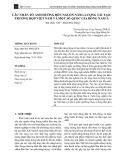
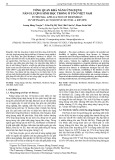
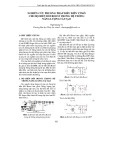






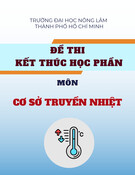
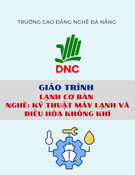
![Ngân hàng trắc nghiệm Kỹ thuật lạnh ứng dụng: Đề cương [chuẩn nhất]](https://cdn.tailieu.vn/images/document/thumbnail/2025/20251007/kimphuong1001/135x160/25391759827353.jpg)






